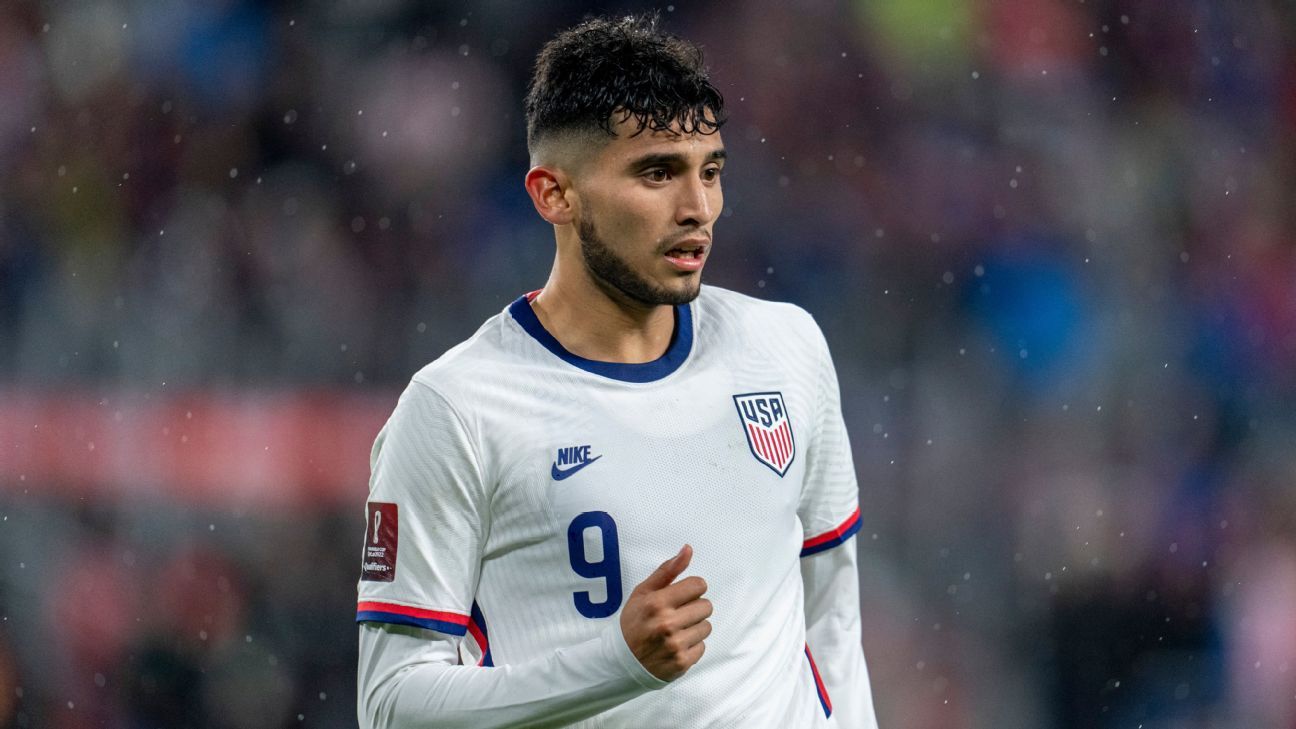A manager’s explanations for a striker who doesn’t score are well known by now.
“His link-up play is excellent.”
“He’s doing the dirty work.”
“He’s getting in good positions. If he wasn’t doing that, then I’d be worried.”
– ESPN+ viewers’ guide: LaLiga, Bundesliga, MLS, FA Cup, more
– Stream ESPN FC Daily on ESPN+ (U.S. only)
– Don’t have ESPN? Get instant access
And so it goes for center-forwards on the U.S. men’s national team ahead of Sunday’s World Cup qualifying encounter with Canada. In Thursday’s 1-0 win over El Salvador, there was Jesus Ferreira, darting this way and that, creating a team-high four chances (per ESPN Stats & Information) and getting credited with a generous assist on Antonee Robinson‘s goal.
Then there were a pair of missed chances in the first half, where converting either one would have done plenty to settle U.S. nerves and likely would have led to a more comfortable victory. In neither case did Ferreira even hit the target. Yet coach Gregg Berhalter has consistently taken the glass-half-full approach in assessing Ferreira’s play in the match.
“He set up a number of other chances and he had chances for himself,” Berhalter said of Ferreira during Saturday’s Zoom call with reporters. “I think that’s all you asked for in a striker, is to be able to provide chances and create and have chances for yourself in each game. And he had that. So we were pleased with his play. His defensive work rate was excellent. He checked all the boxes except for putting the ball in the back of the net.”
As for Ferreira’s lack of finishing, Berhalter said, “The sample size is too small.”
All of these things are true, and it’s Berhalter’s job to try to instill confidence where he can, but the fact that the U.S. manager has turned to five different center-forwards in nine qualifying matches points to there being limits to his patience. At some point, a striker has to start converting his chances.
And if we’re talking about sample size, Ricardo Pepi‘s isn’t all that large either. He has but six international appearances to his name, yet he alone has been responsible for the three goals from center-forwards. There is also a certain comfort that comes from a No. 9 with a nose for goal like Pepi has. There is a greater belief that a half-chance will be converted into a goal.
There is a debate over how much of a worry the lack of goals from strikers actually is. So far in qualifying, the U.S. has shown impressive balance in terms of where the goals come from. Three have come from defenders, two from midfield, four from wide attackers (five if you include the own goal that Timothy Weah forced against Costa Rica) and three from the center-forward position.
All of this points to Berhalter valuing mobility and link-up play more than finishing, at least for the moment. That could easily change against Canada, although that depends on whether the hosts sit back and counterattack, like they did in September during a 1-1 draw, or play more expansively. Berhalter could opt for old standby Gyasi Zardes, a player who knows the U.S. manager’s system well from their time together in Columbus and is willing to engage in the pressing from the front that Berhalter values. But Pepi has the kind of killer instinct that can turn a defeat on the road into a result, be it a draw or a win.
Berhalter said he had spoken with Pepi about how much has been on his plate of late, including his recent move to Bundesliga side FC Augsburg, and the pressure that comes with it.
“We know [Pepi] is going to help this group, both in the short term and the long term,” said Berhalter. “It’s just about being patient. Like any player, we talk about what are we looking for. What’s the specific game plan against this opponent? And then we pick the player that fits it the most. In this particular case, we felt like Jesus fit better. That doesn’t mean Ricardo is not a great player. It doesn’t mean he doesn’t have other strengths. It means that we just chose for Jesus in that particular game.”
There are plenty of moving parts when it comes to the effectiveness of a center-forward. For the U.S., the loss of Weah due to his vaccination status is a blow, although expected replacement Brenden Aaronson has had some bright moments of his own during qualifying, including two goals, but getting Christian Pulisic on track is key to raising the level of the attack.
The Chelsea attacker looked out of sorts against El Salvador, and was ineffective off the dribble. He’ll likely draw plenty of attention against Canada. He was fouled five times during the previous encounter between the two sides in September. If the U.S. can come up with a way to find him more space, whoever lines up at center-forward could be the biggest beneficiary.
The U.S. is in a position where cementing a place at the 2022 World Cup is beginning to come into view. A result on Sunday followed by a win against Honduras on Wednesday in Minnesota, in what are expected to frigid conditions, will get the U.S. within touching distance.
